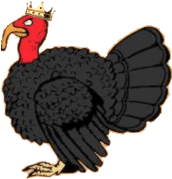
Last night I discovered the Spanish word pavo real, which means peacock, or literally ‘royal turkey’, and which conjured up an image of a turkey in ermine robes wearing a crown.
It also reminds me of the Mandarin Chinese word for swan, 天鵝 [天鹅] (tiān’é), which could be translated as ‘heavenly/celestial goose’. The Mandarin word for peacock is 孔雀 (kǒngquè) or ‘great sparrow’. [source]
The word pavo comes from the Latin pāvō (peacock), from the Ancient Greek ταώς (taōs), and thought to be ultimately from Tamil தோகை (tōkai).
The words for peacock in many European languages come from the same root: Aromanian: pãun; Breton: paun; Catalan: paó; Cornish: payon; Dutch: pauw; French: paon; Friulian: pavon; Galician: pavo, pavón; German: Pfau; Italian: pavone; Occitan: pavon; Old English: pāwa; Portuguese: pavão; Romanian: păun; Romansch: pavun, pivun; Sardinian: paboni, paone; Serbian: paun; Welsh: paun [source]. However in Manx a peacock is a kellagh aalin (‘beautiful cock(rel)’) or a kellagh eairkagh (‘peaked cock(rel)’) [source].
Are there interesting words for peacocks, or other birds, in other languages?
The word pavo has quite a few other meanings in Spanish, including:
– silly thing, idiot; five peseta coin; sucker (in Spain)
– stowaway (in Chile)
– large kite; big shot; evil-looking person (in the Andes)
– youngster, kid
– cold turkey
– silly – e.g. ¡no seas pavo! = don’t be silly!
From: Reverso
I’m skeptical of that etymology of pāvō.
There’s also an English word pawn, referring to peacock in heraldry.
Croatian – paun (peacock), puran (turkey).
The words for “turkey” in European languages tend to be interesting!
English gets turkey, which apparenty originally signified guineafowl, since those came to Europe through Turkey.
German has Truthahn (trut-cock), which is thought to be onomatopoeic (or, says wikipedia, derived from Middle Low German droten, “to threaten”). The oldest German reference also calls them “Calcutta Cocks”, which seems to be another common descriptor — the Scandinavian languages all seem to call it “kalkun” or similar.
French has dinde, which presumably derives from d’Inde, “from India”.
Same with Russian indejki.
Anyone know where Czech “krocan” comes from?
“Krocan” seems to be a strange corruption of German “Truthahn”.
Not surprising, but worthy of mention, is that the word ‘peacock’ is derived from the same source as ‘pavo’, ‘paon’ etc. The Chambers gives ‘pea’ as an obsolete and sexually generic word for a peacock/peahen.
The Tamil word தோகை (tOhai) is used to signify the peacock’s tail/plumage, and by extension, the peacock itself. It is commonly cited as a very early loan word into biblical Hebrew in the form of ‘tuki/tukki’.
In standard contemporary usage, however, the word மயில் (mayil) [cf ‘mayilvAhanan’, a popular given name and epithet of Lord Murugan whose traditional mount, or ‘vehicle’, is the peacock] is preferred in Tamil versus the Sanskrit ‘mayUra’.
In Vietnamese they are known as ‘con công’ and are used in many sayings to represent ‘luxury, high class, fancy’. Other birds in the same family are known as ‘con gà tiền’ (literally ‘money chicken’).
In Sanskrit, besides मयूर mayūra (peacock) and मयूरी mayūrī (peahen), there is the word केकिन् kekin (peacock), from केका kekā (cry of a peacock; imitates the sound).
In Finnish, peacocks are called “riikinkukko”, literally ‘cock of the kingdom’, referring to the kingdom of Sweden, from where the first peacocks came to Finland.
The turkey is called “kalkkuna” in Finnish, and this word is a loan from Swedish as well.
In Japanese, the peacock is called 孔雀 kujaku (great sparrow), as in Chinese.
Lastly, a Sanskrit saying about peacocks, which I still remember from my studies in university:
वरमद्य कपोतः श्वो मयूरात्
varam adya kapotaḥ śvo mayūrāt
Better a pigeon today than a peacock tomorrow.
Very informative post, Rauli. Liked your ‘subhAShita’ at the end too!
Just as is the case with the Sanskrit ‘kEkin’ you mention above, the crow, in Tamil, is named onomatapoeically as காக்கை (kAkkai), [cf Japanese カラスが「かあか」と鳴く」–> ‘karasu ga kAka to naku’ –> the crow cries out ‘kAka’].
Last but not least, the Japanese ホトトギス (hototogisu –> ‘Lesser cuckoo’/nightingale) and キリギリス (kirigirisu –> grasshopper – yes, a slight departure from the avian theme!) of haiku fame stand out and are certainly top on my list of cellar doors!!
Really interesting, because in Arabic, it is T^áwoos [طاووس] and apparently we borrowed the word from Greek.
In Polish, turkey is “indyk,” and peacock is “paw,” with “pawia” the form in the genitive and accusative singular. A slang/vulgar expression for “to vomit” is “puścić pawia,” literally “to release the peacock,” because–as a native Polish speaker explained to me–of the visual similarity of the spread of a peacock’s tail to the display resulting from the vomiting process.
Duck in Polish is “kaczka” (nominative and accusative plural “kaczki”), and “puścić kaczki” (“to release ducks”) is a slang/vulgar expression for “to pass gas audibly.”
Admittedly off topic, but in the same vein, here in southern Indiana, the sounds of gas-passing is sometimes referred to as “Kentucky (or Tennessee) barking spiders.”
The Mandarin term for turkey is “fire chicken”.